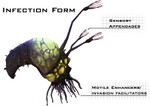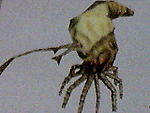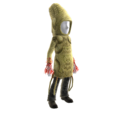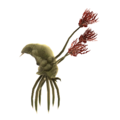Pod infector
From Halopedia, the Halo wiki
| This article does not meet the wiki's general standards and/or standards on layouts. You can help by cleaning this article. |
| This article does not have enough inline citations and/or does not adhere to the proper citation format. You can help Halopedia by adding citations. |
Template:Flood Species Infobox
The Flood infection form is a stage of the virulent Flood xenoform. It is the most commonly seen stage of the Flood, and is the form responsible for spreading the Flood infection.
Overview
Infection forms are the primary vector for the Flood infection. While small (roughly the size of a human torso) and weak, they travel in huge swarms and overwhelm foes using sheer numbers. Once within range of a potential host, they leap for the victim's chest area, rasping away at armor, clothing and flesh with their numerous tentacle-like limbs. These appendages penetrate deep into the body, tap into the victim's spinal cord, and unleash an attack on the host's nervous system via direct contact with the spine, killing the host almost instantly. Once this is accomplished, the form rewrites the neural pathways of the victim's brain with its tendrils, forcing a resonant frequency match between its neural signals and the host's. At this point, the infection form has complete control over the body's motor functions.
As the infection form hacks into the host's nervous system, it releases encapsulated Flood Super Cells into the body. These cells interface with the host's cells, "digest" them and convert their components into new Flood cells. At this point, the infection form burrows into the host body, moving aside the internal organs and taking up residence within the chest cavity (or any approximate equivalent). Having achieved total control over the host, the infection form reshapes the body into a form more suitable for attacking enemies - a combat form.
The speed and intensity of this process occurs at the same rate as an energetic chemical reaction, often taking mere seconds to accomplish. The consequences for the host organism are extreme, as their brains are purged of all traces of their original personality and their bodies are reconstituted into Flood biomatter. The organism effectively becomes a pawn of the Flood's collective intelligence, to be used in any way it deems necessary.
It should be noted that an infection form does not have to implant itself into the host's body cavity to infect a host, as merely inserting spores via a wound is sufficient to infect an organism. Such infection may occur several seconds or perhaps minutes later, yet the transformation will occur almost instantaneously once it has begun.[1]
In exceedingly rare cases, such as if the infection form has been damaged or is incredibly old, it will go through this process without killing the host, leaving them at least partially aware of what is going on, but unable to move or act. This was the fate of UNSC Private Wallace A. Jenkins during the raid on the "Covenant weapons cache" on Installation 04.[2] This aged version of the infection form must have been kept in captivity for far too long, thereby reducing its potential of complete transformation of its host into a Flood combat form. Jenkins survived infection, and even remained conscious, with short periods of time where he could exert control over his mutated body.
An infection form may abandon its host if the corpse has been heavily damaged, and look for a new one. If the infection form inside a combat form has been destroyed, but the combat form itself is intact enough to continue serving its purpose, loose infection forms may burrow inside the body and take the place of the one that mutated it, effectively "re-animating" the combat form.
Weaker host forms
While any large life form with some level of awareness and/or sentience can be infected by an Infection Form, not all of them are suitable to serve the function of Combat Forms, the Flood's signature and preferred mobile form utilized during the Feral Stage. While these hosts are transformed in a similar fashion to the traditional Combat Forms, these forms are not often employed in front line combat for several reasons.
The first of these would be the fact that such life forms, despite their sophisticated nervous systems and adequate levels of sentience, simply lack the necessary biomass, calcium reserves, and physical strength to make first-choice combat units. More specifically, when a host life form is transformed, the activities of the Infection Form require not only the aforementioned levels of biomass, calcium content, and physical strength, but that the host has the physical endurance and stamina to withstand the process. Species such as the Forerunner, Humanity, Sangheili, and the Jiralhanae are almost always turned into combat forms because their biology and physical properties enable them to withstand the infection forms' abilities, which are violent and resource-intensive.
In contrast, weaker life forms, such as the Kig-Yar, Unggoy, and perhaps the Yanme'e, lack these important qualities despite their perfectly adequate levels of sentience and neural complexity. Because of these factors, these lesser hosts are primarily used for other but equally important purposes. These involve multiple mission profiles that are essential to the development of Flood outgrowth: establishment of mobile incubators, biomass and calcium reserves, hive structures, and the components of a coordinating and controlling intelligence.
When utilized for the creation of the hive and the central intelligence, the weaker hosts gather together and merge into single mass or a collection of masses spread around whatever environment the Flood have established themselves in. In this way, the weaker host forms serve as 'building blocks' for the creation of a Flood Hive, which if all goes according to its logical conclusion, will spawn a fully-developed collective and the next stage of the Flood's development: the Coordinated Stage and its crowning achievement, a Gravemind. Surrounding life forms such as significantly smaller animals as well as the full range of plants, microbes, lichens, and fungi, are seized by the growing Flood collective and digested as raw material to create more generic Flood biomass.
The next vital use for lesser hosts is to serve as the second signature form of the Feral Stage, the mobile Infection Form incubator known as a Carrier Form. While these are usually formed from weakened, damaged, and/or aged Combat Forms, weaker host forms are just as frequently employed for this purpose. The first step in the creation of a Carrier Form by this method involves a single appropriate host to function as a nucleus, which is then followed by one or more other weaker forms attaching themselves to the leading unit. The congregated hosts then fuse, with the external host forms being rapidly digested by the central form, with the result being that the other hosts have been reduced to extra, generic biomass, contributing to the structure of the now significantly distorted, bloated incubator.[3]
While this complex methodology is largely standard procedure for the Flood, there are occasionally exceptions to these rules. In at least one notable campaign[4] early in the Human-Covenant War, this mode of operation was contradicted by the Flood. The outbreak present on this installation employed Kig-Yar and Unggoy quite frequently as front line combat units despite their inadequate status, and was also distinct from other outbreaks with the fact that it was predominantly formed out of life forms lacking sentience such as plants, fungi, etc., or those possessing lower levels of sentience, such as the wide range of animals living there.
Immunities and defenses
Energy shielding destroys infection forms on contact, causing them to explode in a small burst of gas and flesh. Conventional body armor is generally ineffective against infection forms; they can easily squeeze through gaps in armor plating, and their rasping tentacles can burrow through rubber, fabric or polymer in order to reach the flesh underneath.
At this time, the only known human to be incompatible with Flood infection forms is Staff Sergeant Avery Johnson due to his supposed contracting of Boren's Syndrome from the residual radiation of a crate full of plasma grenades on Paris IV. In reality, his resistance to Flood infection was due to the augmentations he received as part of the ORION Project.[5]
The Mgalekgolo's lack of a central nervous system and nature as an invertebrate colony consisting of multiple worms likely make them immune to Flood infection.[6] The invertebrate nature of the Yanme'e, along with their hard, chitinous exoskeleton, would seem to make them immune as well. However, while their unique physiologies make standard infection difficult, it is likely that the Flood are still capable of consuming and converting Lekgolo and Yanme'e into Flood biomass.
Combat
In order to overwhelm hosts, Infection forms attack in large swarms, leaping at any nearby targets and attacking with their claws and tentacles. If the victim's shields are active, as explained earlier, the infection form will burst. However, the sheer force of numbers can sometimes deplete a victim's shields, allowing these Flood forms to take control of the host's body.
While individual infection forms are weak, in large numbers they can exert a surprisingly powerful force, being able to shatter doors made of Forerunner alloys.
A single round from any weapon will burst an infection form. For this reason, automatic weapons are recommended. Dual-wielding Plasma Rifles, Brute Plasma Rifles, Spikers or using a UNSC ballistic weapon all work well. The Battle Rifle with its bursts fire can be quite effective and the Shotgun can work well too when shooting at large groups closing in. Try to avoid using weapons such as M6 Handguns, as their rate of fire is very low. Also, try to use Grenades, but be careful as sometimes Infection Forms can be stuck with Plasma Grenades and may harm you when it gets close. In Halo: Combat Evolved, automatic weapons like the Assault Rifle and Plasma Rifle are good on them as well as the Plasma Pistol, and the the Needler can turn out to be a very good alternative as the needles have homing ability. Be careful though, do not stick too many Needles on one at a time while they are close as if you do it will explode and effect you most likely depleting your shields. The best way of using it is to fire a single shot at each Infection Form, which is enough to kill them. SMGs are incredibly effective for taking on swarms of infection forms with its large magazine size and impressive rate of fire. The Sentinel Beam is also extremely effective and can swiftly obliterate entire swarms of infection forms at long ranged distances.
Infection forms are spawned from bulging, sac-like pods in Flood hives, called Flood growth pods. It may be tempting to destroy these sacs, but it is actually more advisable not to, since destroying them will not kill the infection forms inside.
Trivia
- Infection forms are carried and incubated by carrier forms and from Flood growth pods in Flood-infested areas. Try not to destroy these sacs, unless you think you can take them one by one, or swarm by swarm.
- In Halo: The Flood, infection forms are mistakenly referred to as being colored white.[7]
- In Halo: Combat Evolved, if an infection form latches itself onto a Marine or one of the Covenant, instead of mutating the host, it will become irrevocably attached until the host is dead. If at least one infection form manages to leap onto an unshielded player in this game, it will deal a noticeable amount of damage (this will increase depending on difficulty and number of infection forms attached), fall off, and attempt to strike the player again. This effect on the player also appears in Halo 3.
- In contrast to the above fact, in Halo 2, should an infection form leap onto any unshielded biological life form (including player characters), death is near instantaneous, though the victim will remain unmutated. The only known character who cannot be killed by an infection form in this game is Rtas 'Vadum.
- An Energy Sword will not lose energy by killing infection forms in Halo 2 and Halo 3, but this method is highly ineffective as infection forms are extremely hard to hit with an Energy Sword.
- The Tank Form has the ability to spit out infection forms. This is demonstrated during Halo 3 for the Tank Form and Halo 2 for Gravemind.
- Infection forms do not add points to your meta-score when the Campaign Scoring is activated in Halo 3. This is most likely because infection forms come in swarms, and could be used to rack up points with almost no effort.
- Infection forms operate in a similar fashion to the chestbuster Xenomorph (being inside a host's chest) and the facehugger Xenomorph of the Alien franchise, the Borg Nanoprobes of the Star Trek franchise, the Headcrabs from the Half-Life series, and the Thing from the John Carpenter film of the same name.
- The infection forms in Halo 3 float in water. Thus, they cannot infect corpses that are in water ponds because of this animation. (E.g. on the level Halo it will appear different close up then it will farther away.) However, in Halo: Combat Evolved, they sink.
- In the book Halo: The Flood, an infection form almost infected John-117 when he turned his back, due to his energy shields being drained.
- According to the book, Halo: The Flood, the infection forms make a "meep" sound. This can be heard in the games, although it sounds more like an ominous droning.
- In Halo: Combat Evolved, if you shoot one infection form in a swarm, it will pop and cause a chain reaction causing all the other infection forms to pop with it in the swarm. This was less effective in Halo 2, but returned in Halo 3 (although not as powerful as in Halo: Combat Evolved).
- Several can be seen within the Flood Observation chamber on the Halo 3 Multiplayer map Cold Storage. These Flood make Cold Storage the 6th multiplayer map with NPC enemies (Along with Construct, Guardian, Last Resort, Epitaph and Isolation which have Sentinels, Constructors, seagulls or pterodactyl-like birds flying around). However, you cannot get to them.
- In Halo: Combat Evolved, the infection forms have a pulsating glow in the dark.
- The infection form was featured in Halo Wars as a non-playable unit for the Flood. They have the ability to crawl over walls, being able to reach ground no other forces can reach and transform most infantry into Combat Forms.
- On the Halo 3 level Halo, when in the Warthog, Mongoose, Chopper, etc., if you drive into the infection forms you simply drive over them, possibly flipping your vehicle. Performing this action kills all other Flood forms including the carrier forms, although the latter explode violently on contact.
- In Halo: Combat Evolved, if players listen close enough to the droning sounds emitted by the Infection Forms, it can be noted that the sounds are actually the same sounds used for "Pfhor Fighters" death screams and occasional random chattering from the Marathon franchise. However, the sounds have a slightly higher pitch, as well as oozing sounds, which make the reuse of the sound effect from Marathon almost completely unnoticeable.
- In Halo 3, despite their seemingly weak form, they can actually move certain objects that are bigger than they are. This can be observed in the crashed ship on the Halo 3 level Floodgate and in the level Cortana.
- In Halo: Combat Evolved it is possible to "stick" an infection form with a plasma grenade.
- In Halo Wars, when Sergeant Forge shoots the Flood infection forms that are attacking Professor Anders, they do not pop like all other infection forms. Instead, they simply fall lifelessly to the ground.
- In Halo PC, if the player uses cheat_bump_possession to take over a Marine or a Grunt, they will have no control over their body if an infection form latches onto them.
Gallery
- BabyFloodCloseup.jpg
An infection form in Halo 2.
Infection Forms assaulting Professor Anders.
An Xbox 360 Avatar customized with a Flood Infection Form suit.
The Librarian investigating a Flood infection form.
List of appearances
Sources
- ^ Halo Wars, campaign level Anders' Signal
- ^ Halo: The Flood, page 176
- ^ 'Halo: The Flood', page 291
- ^ Halo Wars
- ^ Halo Graphic Novel, page 122
- ^ Halo: First Strike
- ^ Halo: The Flood page 174
| ||







